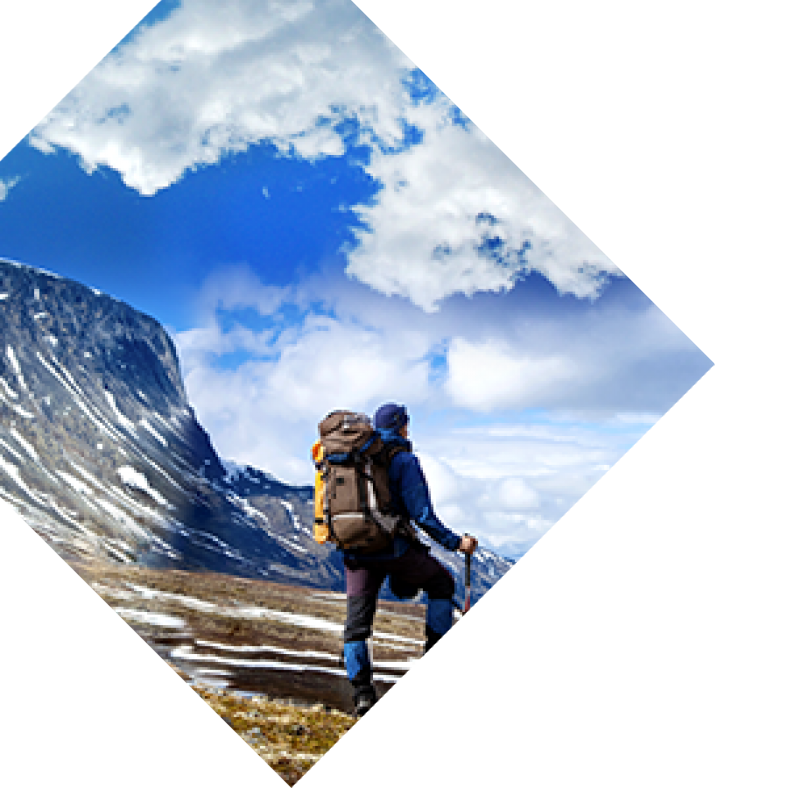Meet GORE-TEX Products fan Tyler Norris. For those who know him personally, the mountains are more often his home than the residence he pays rent for. We asked him to walk through his experience with tennis shoes, and why he made the switch to hiking boots. A couple weeks ago I read an article titled “5 Reasons To Ditch Your Hiking Boots” by CleverHiker. The writer talked about thru-hikers using tennis shoes (mostly trail running shoes) on longer hikes because they couldn’t handle the weight and bulkiness of hiking boots. Let me be clear, I’m not saying Dave Collins of CleverHiker is wrong in his assessment, as much as I’m saying not everyone can or should ditch hiking boots outright. To do so, I’m going to walk through my personal decision to stop hiking in tennis shoes, only use hiking boots, and why I haven’t gone back.
1. Hiking boots traction action
I attribute one of my most embarrassing hiking moments to a pair of tennis shoes. I was walking around in my tennis shoes at Fossil Springs and slipped backward on some rocks. Lucky for me, the fall hurt my pride more than my body. But imagine that misfortune on a serious section of a hike or while hiking near others. Embarrassment is nothing compared to a fall from perilous heights or a tumble into innocent bystanders. Tennis shoes may excel on concrete or groomed trails, but they’re often too flexible to give you uncompromised traction in the wild. Many hiking boots feature Vibram soles and heel brakes that deliver optimal control on the trail. I’ve learned that a lack of traction is a step in the wrong direction.
2. Your ankles need a boot they can lean on
Rolling your ankle sucks. You’d think I would have learned by now, but I do it all the time when I play pickup basketball in my cross-trainers. I see it with hikers who don’t wear the right footwear even more. To avoid rolled ankles, I always wear hiking boots that rise at least to my ankle, if not above. Think about the discomfort when you roll an ankle on the basketball court. Sure, you mutter a few expletives and awkwardly hobble to the car, but then you drive home to heal. A rolled ankle on the trail is a different story. You need to be able to make it back out, and that means putting your full weight on your ankle. If I can mitigate that risk by wearing hiking boots with solid ankle support, I’m all for it. To be more specific, I sport either my Mammut Comfort High GTX® SURROUND® Boots (for warmer weather hiking and backpacking) or Salomon QUEST 4D 2 GTX® Boots (for cooler weather hiking and backpacking). I can appreciate people who prefer the lightweight nature of trail runners and tennis shoes. But I refuse to put myself in harm’s way over a few extra ounces. Modern hiking boots, even high boots, are amazingly light these days.
3. The occasional boulder and root hurt less, a lot less
I try to be as careful as possible on the trail, watching where I step as I follow the leader. But there always seems to be a pesky root or rock that appears just as I look off to the horizon. And my toes pay the price. Or at least they would, if I were wearing tennis shoes. A solid upper does a world of difference if you’re ever in that situation, because it offers extra protection. But you can’t get an upper like that unless you invest in a hiking boot. Look in the mirror and tell yourself that you’re OK with losing a toenail on your next hike. If you can’t, stick to the boots.
4. Nobody’s got time for wet shoes on a hike
Even in Arizona (where I live), we have creeks, rivers, and waterfalls, and the weather can be unpredictable. You never know when a storm may blow through, and to protect my feet from the elements, a nice pair of waterproof hiking boots is simply a must in my book. If you’ve never hiked in wet shoes or boots, I’d equate the experience to tying those sand weights your mom would use for working out on your legs and trying to hike. Every individual movement requires twice the effort. And then there’s the discomfort of your feet pruning and that awful squishing noise that accompanies each step you take. Thankfully, there have been some unreal innovations that help with breathability.
5. Tennis shoes won’t last
I read a statistic somewhere that runners need swap out their running shoes every six months. If that’s the case for running on the street, think how frequently you’d have to change them out if you used them on rough terrain. When I think of the typical tennis shoes used solely for running, I think of these. And they definitely weren’t made for the trail. I said this earlier, but I’ll say it again: Tennis shoes are not built to withstand trail conditions. They’ll tear and rip. When it comes to choosing between a sturdy and not-so-sturdy option for hiking, always go with the sturdy version. I’m not expecting you to have this crazy revelation about hiking in tennis shoes now that you’ve read my story. That’d be silly. Do what’s best for you and if that means hiking in tennis shoes, great! But for those of you thinking it’s time to make the switch, it’s time to match the terrain to the boot so you can make the right choice. If you have any other questions about this topic, let’s talk about it on the GORE-TEX North America Facebook Page and I’ll be there to answer ’em! Thanks for reading. Now get outside and hike! Seriously, it’s beautiful outside.
You may also enjoy
View all articles in this category
Science & Technologies
Happy Earth Day - Why Your Actions Matter More Than Ever This Earth Day

GORE-TEX Studio
The GORE-TEX Brand and ettresex® Unveil "Future Envisions" Pop-Up in Stockholm: A Fusion of Functionality, Fashion, and Sustainability




